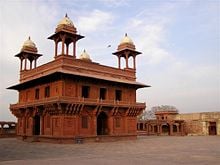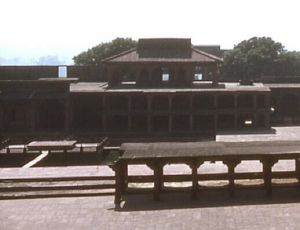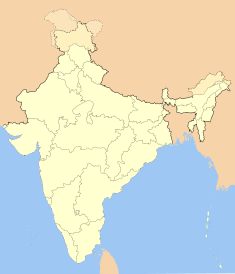Fatehpur Sikri
| Fatehpur Sikri* | |
|---|---|
| UNESCO World Heritage Site | |

| |
| State Party | |
| Type | Cultural |
| Criteria | ii, iii, iv |
| Reference | 255 |
| Region** | Asia-Pacific |
| Inscription history | |
| Inscription | 1986 (10th Session) |
| * Name as inscribed on World Heritage List. ** Region as classified by UNESCO. | |
Fatehpur Sikri(Hindi: फतेहपूर सिकरी, Urdu: فتحپور سیکری) is a city and a municipal board in Agra district in the state of Uttar Pradesh, India. It was the political capital of India's Mughal Empire under Akbar's reign, from 1571 until 1585, when it was abandoned, ostensibly due to lack of water. It is located in what is now Uttar Pradesh, India.
History and Significance
Built in honour of Sufi saint Salim Chishti in 1571 by Mughal emperor Akbar.
The fort is situated at 27° 05' N latitude and 77° 39' E longitude and a mean altitude of 708 meters above sea level.
Fatehpur Sikri shared its imperial duties as a capital city with Agra, where a bulk of the arsenal, treasure hoards, and other reserves were kept at its Red Fort for security. During a crisis, the court, harem, and treasury could be removed to Agra, only 26 miles away, less than a day's march.
Innovations in land revenue, coinage, military organisation, and provincial administration emerged during the Fatehpur Sikri years.
It is regarded as Emperor Akbar's crowning architectural legacy. Indeed, its numerous palaces, halls, and masjids satisfy his creative and aesthetic impulses, typical of Mughals.
Fatehpur Sikri is a World Heritage Site. Some contemporary Indian architects, notably B. V. Doshi, have cited it as an important source of inspiration. Architect or layperson, this city generally captures the imagination and wonder of all who experience its urban spaces and see its buildings. Charles and Ray Eames, cited Fatehpur Sikri in the landmark 'India Report' that led to the conception of the National Institute of Design, India's premiere design school.
It is here, that the legends of Akbar and his famed courtiers, the nine jewels or navaratnas, were born. The legendary musician Tansen is said to have performed on an island in the middle of the tank Anup Talao (lit. anup= without metaphor, unmatched).
Eventually, it is believed that water sources dried up and the fort had to be abandoned.
Design
| Fatehpur Sikri Uttar Pradesh • India | |
| Coordinates: | |
| Time zone | IST (UTC+5:30) |
| District(s) | Agra |
| Population | 28,754 (2001) |
Coordinates:
The layout of the city shows a conscious attempt to produce rich spatial effects by the organization of built forms around open spaces in interesting ways. Of particular note is the way in which shifts in axes occur as one moves along the city and the location of squares in important places with buildings forming a backdrop or envelope.
Unlike other important Mughal cities (such as Shahjahanabad, which has a very formal planning), Fatehpur Sikri has aspects of informality and improvisation. Indeed, the newly constructed city bore a similarity to the movable imperial encampment also designed by Akbar.
Important buildings
The buildings of Fatehpur Sikri show a synthesis of various regional schools of architectural craftsmanship such as Gujarati and Bengali. This was because indigenous craftsmen from various regions were used for the construction of the buildings. Influences from Hindu and Jain architecture are seen hand in hand with Islamic elements. The building material predominantly used is red sandstone, quarried from the same rocky outcrop on which it is situated.
Some of the important buildings in this city, both religious and secular buildings, are:
- Naubat Khana – Drum house: near the entry, where important arrivals are announced.
- Diwan-i-Am – Hall of Public Audience: a building typology found in many Mughal cities where the ruler meets the general public. In this case it is a pavilion like multi-bayed rectangular structure fronting a large open space.
- Diwan-i-Khas – Hall of Private Audience: famous for its central pillar with thirty-six voluted brackets supporting a circular platform for Akbar.
- Raja Birbal's house: the house of Akbar's favourite minister, who was a Hindu. Notable features of the building are the horizontal sloping sunshades or chajjas and the brackets which support them.
- Jodhabai's palace: The building shows Gujarati influence and is built around a courtyard, with special care being taken to ensure privacy.
- Pachisi Court: a square marked out as a large sized board game (modern day Ludo) where live coins- people- participated.
- Char Chaman Tank: a tank with a central platform and four bridges leading up to it.
- Panch Mahal: A five-storied palatial structure. The bottom floor has 176 intricately carved columns.
- Buland Darwaza – the 'Gate of Magnificence': one of the gateways to the Jami masjid, a stupendous piece of architecture from the outside, gradually making a transition to a human scale in the inside.
- Jama Masjid: the mosque, built in the manner of Indian mosques, with liwans (aisles) around a central courtyard. A distinguishing feature is the row of chhatris (small domed pavilions) over the sanctuary.
- Tomb of Salim Chisti: a white marble encased tomb within the Jama mosque's courtyard.
Demographics
As of 2001 India census[1], Fatehpur Sikri had a population of 28,754. Males constitute 53% of the population and females 47%. Fatehpur Sikri has an average literacy rate of 46%, lower than the national average of 59.5%: male literacy is 57%, and female literacy is 34%. In Fatehpur Sikri, 19% of the population is under 6 years of age.
Notes
ReferencesISBN links support NWE through referral fees
- Bahn, Paul G. 1999. Lost cities. New York: Welcome Rain. OCLC 41272747.
- Gaur, R. C. 2000. Excavations at Fatehpur Sikri: a national project. New Delhi: Aryan Books International. ISBN 9788173051784.
- Nath, R., and R. Nath. 1988. Architecture of Fatehpur Sikri: forms, techniques & concepts. Jaipur, India: Historical Research Documentation Programme. ISBN 9788185105093.
- Petruccioli, Attilio, and Thomas Dix. 1992. Fatehpur Sikri. Berlin: Ernst & Sohn. ISBN 9783433027059.
- Sharma, D. V. 2008. Archaeology of Fatehpur Sikri: new discoveries. New Delhi: Aryan Books International. ISBN 9788173053221.
External links
- Fatehpur Sikri in UNESCO List. Retrieved July 8, 2008.
- Guide to Fatehpur Sikri. Retrieved July 8, 2008.
- - photographs of Fatehpur Sikri and other sites of UP. Retrieved July 8, 2008.
- UNESCO Virtual Tour of the Monuments at Fatehpur Sikri. Retrieved July 8, 2008.
- Pictures of Fatehpur Sikri. From a backpackers trip around India in 2005.. Retrieved July 8, 2008.
- Pictures of Fatehpur Sikri - Terra Galleria. Retrieved July 8, 2008.
| |||||||
Credits
New World Encyclopedia writers and editors rewrote and completed the Wikipedia article in accordance with New World Encyclopedia standards. This article abides by terms of the Creative Commons CC-by-sa 3.0 License (CC-by-sa), which may be used and disseminated with proper attribution. Credit is due under the terms of this license that can reference both the New World Encyclopedia contributors and the selfless volunteer contributors of the Wikimedia Foundation. To cite this article click here for a list of acceptable citing formats.The history of earlier contributions by wikipedians is accessible to researchers here:
The history of this article since it was imported to New World Encyclopedia:
Note: Some restrictions may apply to use of individual images which are separately licensed.








